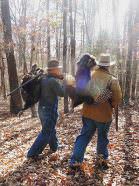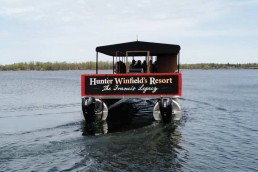Once Secrets now Disclosed: Time to be a Fall Turkey Hunter
In the Ozarks, all old-time turkey hunters were fall hunters. In the 1960s, the old timers did not want a spring season. They thought gobblers too easy to kill when they’re weak with passion brought on by the spring mating season. To see them in action, you would have believed them to be right, because experienced fall turkey hunters make absolute assassins in the spring woods. In fall turkey hunting, you use more vocalizations, and learn to use the pecking order to challenge turkeys. Once you learn to do that, you can use those same skills to kill turkeys in the spring when the mating season is “off” and everybody is complaining about the turkeys.
But let’s get out there, high on an Ozarks river bluff, for one of my favorite fall hunts ever…
A beautiful autumn dawn breaks in the Missouri Ozarks river hills. It’s cold. Frost flowers are scattered across the forest floor as we cross the head of a river hollow.
I’m sharing the hills with Gary Johnson, a hunting buddy from Indiana. He’s toting flint, steel, and white smoke in the form of “Lady Die,” his long-barreled flintlock, smoothbore, muzzleloader shotgun. I’m carrying a ton of video gear, so atop a steep, narrow ridge, we pause to catch our breath––but it’s taken away again by the sparkling, reflective frost showcased in early-morning light that flits through the trees. We stand there quietly, watching steam rising from the winding river far below, and mist rising across the mountains. We say nothing, but the message resounds, carried by the sights, sounds and aroma of the October hills.
Sometimes, words are unnecessary.
Fall turkey hunting is one of my strongest passions. Maybe it’s because of my love for the Missouri Ozarks, strengthened by all those fall seasons (I have hunted fall turkeys here every year since 1975). Certainly, it comes from the early years hunting the Ozarks as a little boy.
I think about how so many of today’s hunters have never experienced this type of morning, and although I don’t know it yet, this is the kind of morning that would turn any true hunter into a fall gobbler fanatic. A big percentage of Missouri turkey hunters only chase the birds in spring, as fall turkey permit sales continue to fall. The soft, gold morning light breaking across the hollers and rock river bluffs holds me in place long after I am ready to move on, and I’m reminded that, if I had to choose, I would pick fall gobbler hunting, hands down, over spring gobbler hunting. And reminded that if you become a good fall turkey hunter you will be a vastly improved spring turkey hunter, because you’ll be able to call gobblers no matter what kind of approach is needed.
There was a time when I held such information close to the vest. That time has passed. I want you to become a good fall turkey hunter, and I will tell you everything you need to know, and show you in my videos, here in MidWest Outdoors.
Challenging fall gobblers
When hunting fall gobblers, your calling strategy is to insert yourself into the never-ending battle for prime spots in a flock’s pecking order. You’re talking “bird to bird,” as I like to call it, gobbler to gobbler. You challenge birds with gobbler yelps, along with cutting and aggressive purring. You sound like you’re the new bird in the area, and they just have to come and see who you are.
In a nutshell, that is the core of fall gobbler hunting. Even though it’s a simple concept, most fall hunters are not aware of it. If you want to shoot a hen or young bird, call like a hen or lost poults. But if you want to bring in the big boys, those spur-packin’ black-breasted toms with bright red heads and swingin’ beards, talk like one of them.
The ‘yowk’ of a gobbler yelp is a little longer in length, and a little bit slower, than hen yelping. Hens normally yelp with shorter notes that are faster in rhythm. Gobblers have a slower cadence.
Retro turkey hunt
We are attending the Ozarks media “retro hunt” featuring old guns, old-time clothing, even old-time calling devices. No modern guns, calls, camo or ammo. Our camp is set up on private ground, but (as if hunting retro is not tough enough) we are hunting public ground, state and national forest. Gary and I have hunted hard for three days without much luck. To this point, it’s been a tough fall season, and while trying to capture hunts on camera, using a flintlock, carrying a tripod with a big video camera and microphone with long cords, it’s been a supreme challenge.

The routine––and this shows you that all of us have to work hard, a lot of times, to find success––is to cover ground, despite all the gear we’re lugging. The game is to move, set up, call, and move again if we don’t get a response. We’re propelled by the spirit of a hopeful hunter on this beautiful ridge.
Just after daylight arrives, on our third setup, Gary taps me on the shoulder. He indicates that he can hear a gobbler “popping,” so I get on the call, letting it rain coarse putting back at the bird. Aggressive gobbler cutting rifles back and we are in business.
I hunker down behind my camera and stare across the logging road, looking for movement. I see them coming, just under the ridge on the river side, bobbing, beaks popping, snake-like heads, at least a dozen gobblers breaking the ridge edge, coming right at us.
It’s amazing how it happens like this, and you all know what I’m talking about; you put in days, sometimes, of hard effort and in a few seconds it all comes together and you don’t have time to do anything but react. I push the camera in to capture this unbelievable site of a herd of adult gobblers in the early morning light. I call and they break into strut, and gobble, all on camera. When I show footage like this at seminars, it helps drive home the message that gobblers strut and gobble all year long––and most of the time, it has to do with pecking order, not mating.
As the flock moves to my left, Lady Die roars her song of flint, steel and white smoke. When the smoke clears (you have no idea how long I’ve waited to write that), Gary has his fall gobbler, with a flintlock, all on camera. Quite a feat, but more important is the hunt, and the camp, we have shared together in these hills.
Finding time for fall gobblers
Scattered among the bounty of fall hunting options is the wild turkey season, a new opportunity in many states and a long-held tradition in others. In the tug of war over your hunting time and priorities, it can be too easy to blow it off in favor of more days in the deer stand, more mornings over goose decoys, more time following your dog through upland bird fields. After all, you can always hunt turkeys in the spring, right?
With due respect to all other October callings, a fall hunt for turkeys can stand on its own merits. If approached with calling as a central focus, fall turkey camp becomes a can’t-miss tradition. The fall season is commonly thought of as time to intentionally bust up flocks of young-of-the-year poults, then call the birds back up, with you playing the role of momma hen or one of the scattered youngsters. That is a fun tactic, but engaging adult birds in autumn conversation, particularly gobblers, is perhaps the biggest thrill in all of turkey hunting.
And for most hunters, a thrill undiscovered.
Ray Eye is a MidWest Outdoors hunting instructor. He was raised in the turkey-rich hills of the Missouri Ozarks, and is considered the dean of America’s professional turkey hunters. It’s less widely known that he is an expert hunter for many other species. Eye has produced an online course, “Calling is Everything,” that details how to call turkeys at any season of the year. Find it at eyesontheoutdoors.com.
MWO
SHARE THIS POST
Did you enjoy this post?
You can be among the first to get the latest info on where to go, what to use and how to use it!
Ray Eye
Ray Eye is an award-winning outdoor communications giant. Eye has a huge following with writing, radio, television and national seminars. This Missouri native is a Missouri Conservation Communicator of the Year, NWTF national Communicator of the Year and was inducted into the “Legends of the Outdoors” National Hall of Fame.



